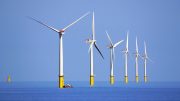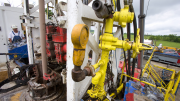While fossil gas is often seen as a transition fuel towards a fully decarbonised energy mix, GE Gas Power sees low-carbon gas as “a destination technology” with the potential to convert power plants to run 100% on clean hydrogen by 2030.
“Today, we have a 50% hydrogen capability for combustion in our largest baseload gas turbines” used for power generation, said Martin O’Neill, vice president at GE Gas Power.
The company’s objective, he explained, is to continue research and development in order “to advance the percentage of hydrogen combustion capability towards 100% by 2030,” he told a EURACTIV event earlier this month.
However, getting there would require a rapid scale up in the production of clean hydrogen, he added. And that will only be possible if multiple sources of low-carbon hydrogen are added to the mix, including so-called “blue hydrogen” where emissions are somehow captured and stored.
In July last year, the European Commission unveiled proposals to develop 100% clean hydrogen production from renewable electricity, with plans to install at least 6 gigawatts of electrolysers in the EU by 2025 and at least 40 gigawatts by 2030.
More than 95% of hydrogen today is produced from natural gas steam reforming, a carbon-intensive process which adds to global warming emissions.
“We think the mix of carbon capture and sequestration now in a decade of action, with layered introduction of blue and green hydrogen is the future,” O’Neill said.
In that perspective, “gas turbine power generation technology becomes a destination technology, not just a bridge,” he added.
“But we need to act now,” he insisted, calling for “policy incentives and mechanisms” in order to “get emissions reduction immediately instead of waiting for technology to come to scale 10,15, or 20 years from now”.
The European Union has agreed tougher climate goals for 2030 and 2050, as part of plans to become climate neutral by mid-century.
While this is hastening the demise of coal, attention is now turning to fossil gas, which overtook lignite as the largest source of power sector emissions in 2020, according to recent data.
Over time, Europe’s climate agenda is also expected to hit the gas sector. In February, Siemens Energy AG announced it was planning to cut 7,800 jobs from its gas and power division by 2025 as the company adjusts to a market that is moving away from fossil fuels and towards renewables.
Gas on ‘case-by-case basis’
Still, gas demand is expected to remain strong in the short term, as EU countries like Poland replace ageing coal power plants with cleaner-burning gas power stations.
“The next 10 years for gas are probably relatively positive, even for unabated gas,” said Jonathan Stern from the Oxford Institute for Energy Studies. Though demand in some places will decrease due to decarbonisation goals, other countries will see an increase because of the coal switch, he said.
The European Commission has taken a cautious stance. Natural gas “can accelerate the phase out of coal” in countries like Poland, which currently rely heavily on coal for electricity production, acknowledged Ditte Juul Jørgensen, director general at the European Commission’s energy department.
“But this has to be looked at on a case-by-case basis,” she added, warning that “in other situations, we risk having an investment into something that could become a stranded asset. And that would actually stand in the way of a shift directly away from coal into to renewable energy,” she said.
Looking beyond 2030, “it’s clear that fossil gas is not part of a long term solution,” Jørgensen said. “And certainly in 2050, we do not see a role for unabated fossil gas in our system”.
Infrastructure funding
Jørgensen also made clear that EU funding for cross-border fossil gas projects will stop, saying future funding will focus on clean gas infrastructure like hydrogen or links to electrolysers.
Not all policymakers agree with this, though. Maria Spyraki, a Greek member of the European Parliament, insisted on “the need to recognise the different pace of decarbonisation in different EU member states,” and spoke in favour of supporting the development of local gas grids in coal-reliant regions.
“The main issue we face in Western Macedonia is that there is no local infrastructure for sharing gas,” Spyraki said, adding that there is currently no European funding available for this. “We have to reconsider how we can support the local infrastructure for natural gas,” while “repurposing and retrofitting the existing infrastructure” for hydrogen in the long run, she added.
O’Neill agreed, saying that “different member states are at different starting points” and will need fossil gas to support their exit from coal.
However, that doesn’t prevent retrofitting existing natural gas turbines to run on hydrogen. “Retrofitting of hydrogen capability into existing gas turbine technology is entirely plausible,” O’Neill said. Many of GE’s existing gas turbines “already have the capacity to ingest significant quantities of hydrogen” and synthetic gases, he added.
“Basically, our intention is to retrofit as increasing percentages of hydrogen become available,” he said.
The European Commission’s hydrogen strategy, presented in July last year, says clean hydrogen could meet 24% of the world’s energy demand by mid-century, with annual sales in the range of €630 billion.
On balance, the EU executive expects that low-carbon gases will gradually replace fossil gas by 2050, with consumption remaining at similar levels.
“What we are currently estimating is that total gas consumption of gaseous fuels in 2050 will be more or less comparable to what it is in 2030 but it should be a shift away from fossil gas to low-carbon and renewable gas,” Jørgensen said.
[Edited by Josie Le Blond]
May 12, 2021




